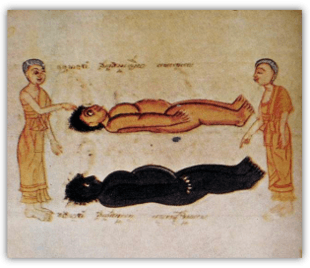Kammaṭṭhāna
In Buddhism, kammaṭṭhāna is a Pali word (Sanskrit: karmasthana) which literally means the place of work. Its original meaning was someone's occupation (farming, trading, cattle-tending, etc.). It has several distinct but related usages, all having to do with Buddhist meditation.

| Part of a series on |
| Buddhism |
|---|
 |
|
|
|
Etymology
Its most basic meaning is as a word for meditation. In Burma senior meditation practitioners are known as "kammatthanacariyas" (meditation masters). Buddhaghosa uses "kammatthana" to refer to each of his forty meditation objects listed in the third chapter of the Visuddhimagga, which are partially derived from the Pāli Canon.[2]
In the Pali literature, prior to the post-canonical Pali commentaries, the term kammaṭṭhāna comes up in only a handful of discourses and then in the context of "work" or "trade."[note 1]
The Thai Forest Tradition names itself Kammaṭṭhāna Forest tradition.
Buddhaghosa's forty meditation subjects
Of the forty objects meditated upon as kammatthana, the first ten are 'things that one can behold directly', 'kasina', or 'a whole':
- (1) earth, (2) water, (3) fire, (4) air, wind, (5) blue, (6) yellow, (7) red, (8) white, (9) enclosed space, (10) bright light.
The next ten are objects of repulsion (asubha):
- (1) swollen corpse, (2) discolored, bluish, corpse, (3) festering corpse, (4) fissured corpse, (5) gnawed corpse, (6,7) dismembered, or hacked and scattered, corpse, (8) bleeding corpse, (9) worm-eaten corpse, (10) skeleton.
Ten are recollections (anussati):
| Thai Forest Tradition | ||||||||||||||||||||||||||||||||||||||
|---|---|---|---|---|---|---|---|---|---|---|---|---|---|---|---|---|---|---|---|---|---|---|---|---|---|---|---|---|---|---|---|---|---|---|---|---|---|---|
 | ||||||||||||||||||||||||||||||||||||||
| Bhikkhus | ||||||||||||||||||||||||||||||||||||||
|
||||||||||||||||||||||||||||||||||||||
| Sīladharās | ||||||||||||||||||||||||||||||||||||||
|
||||||||||||||||||||||||||||||||||||||
| Related Articles | ||||||||||||||||||||||||||||||||||||||
- First three recollections are of the virtues of the Three Jewels:
- Next three are recollections of the virtues of:
- (4) morality (Śīla)
- (5) liberality (cāga)
- (6) the wholesome attributes of Devas
- Recollections of:
- (7) the body (kāya)
- (8) death (see Upajjhatthana Sutta)
- (9) the breath (prāna) or breathing (ānāpāna)
- (10) peace (see Nibbana).
Four are stations of Brahma (Brahma-vihara):
- (1) unconditional kindness and goodwill (mettā)
- (2) compassion (karuna)
- (3) sympathetic joy over another's success (mudita)
- (4) evenmindedness, equanimity (upekkha)
Four are formless states (four arūpajhānas):
- (1) infinite space
- (2) infinite consciousness
- (3) infinite nothingness
- (4) neither perception nor non-perception.
One is of perception of disgust of food (aharepatikulasanna).
The last is analysis of the four elements (catudhatuvavatthana): earth (pathavi), water (apo), fire (tejo), air (vayo).
Each kammatthana can be suggested, especially by a spiritual friend (kalyāṇa-mitta), to a certain individual student at some specific point, by assessing what would be best for that student's temperament and the present state of his or her mind.[8]
Meditation subjects and jhanas
| Rupajhāna | ||||
| First jhāna | Second jhana | Third jhana | Fourth jhana | |
|---|---|---|---|---|
| Kāma / Akusala dhamma (sensuality / unskillful qualities) |
secluded from; withdrawn |
Does not occur | Does not occur | Does not occur |
| Vitakka (applied thought) |
accompanies jhāna |
unification of awareness free from vitakka and vicāra |
Does not occur | Does not occur |
| Vicāra (sustained thought) | ||||
| Pīti (rapture) |
seclusion-born; pervades body |
samādhi-born; pervades body |
fades away (along with distress) |
Does not occur |
| Sukha (non-sensual pleasure) |
pervades physical body |
abandoned (no pleasure nor pain) | ||
| Upekkhāsatipārisuddhi (pure, mindful equanimity) |
Does not occur | internal confidence | equanimous; mindful |
purity of equanimity and mindfulness |
| Sources: [9][10][11] | ||||
According to Gunaratana, following Buddhaghosa, due to the simplicity of subject matter, all four jhanas can be induced through ānāpānasati (mindfulness of breathing) and the ten kasinas.[12]
According to Gunaratana, the following meditation subjects only lead to "access concentration" (upacara samadhi), due to their complexity: the recollection of the Buddha, dharma, sangha, morality, liberality, wholesome attributes of Devas, death, and peace; the perception of disgust of food; and the analysis of the four elements.[12]
Absorption in the first jhana can be realized by mindfulness on the ten kinds of foulness and mindfulness of the body. However, these meditations cannot go beyond the first jhana due to their involving applied thought (vitaka), which is absent from the higher jhanas.[12]
Absorption in the first three jhanas can be realized by contemplating the first three brahma-viharas. However, these meditations cannot aid in attaining the fourth jhana due to the pleasant feelings associated with them. Conversely, once the fourth jhana is induced, the fourth brahma-vihara (equanimity) arises.[12]
Meditation subjects and temperaments
All of the aforementioned meditation subjects can suppress the Five Hindrances, thus allowing one to fruitfully pursue wisdom. In addition, anyone can productively apply specific meditation subjects as antidotes, such as meditating on foulness to counteract lust or on the breath to abandon discursive thought.
The Pali commentaries further provide guidelines for suggesting meditation subjects based on one's general temperament:
- Greedy: the ten foulness meditations; or, body contemplation.
- Hating: the four brahma-viharas; or, the four color kasinas.
- Deluded: mindfulness of breath.
- Faithful: the first six recollections.
- Intelligent: recollection of marana or Nibbana; the perception of disgust of food; or, the analysis of the four elements.
- Speculative: mindfulness of breath.
The six non-color kasinas and the four formless states are suitable for all temperaments.[12]
See also
- Anapanasati
- Buddhist meditation
- Jhana in Theravada
- Samatha
- Vipassanā
Notes
- For instance, in the first three nikayas, the term is found only in the Subha Sutta (MN 99), although there it is found 22 times. In this discourse, it is contextualized, for instance, in this question to the Buddha by the Brahmin Subha:
- "Master Gotama, the brahmins say this: 'Since the work of the household life [Pali: gharāvāsa-kammaṭṭhāna] involves a great deal of activity, great functions, great engagements, and great undertakings, it is of great fruit. Since the work of those gone forth [Pali: pabbajjā-kammaṭṭhāna] involves a small amount of activity, small functions, small engagements, and small undertakings, it is of small fruit.' What does Master Gotama say about this?"[3]
- "And what does it mean to be consummate in initiative? There is the case where a lay person, by whatever occupation he makes his living [Pali: yena kammaṭṭhānena jīvikaṃ kappeti] — whether by farming or trading or cattle tending or archery or as a king's man or by any other craft — is clever and untiring at it, endowed with discrimination in its techniques, enough to arrange and carry it out. This is called being consummate in initiative."[4]
- "What do you think, Sakyans. Suppose a man, by some profession or other [Pali: yena kenaci kammaṭṭhānena], without encountering an unskillful day, were to earn a half-kahapana. Would he deserve to be called a capable man, full of initiative?" [7]
References
- from Teaching Dhamma by pictures: Explanation of a Siamese Traditional Buddhist Manuscript
- Buddhaghosa & Nanamoli (1999), pp. 90–91 (II, 27–28, "Development in Brief"), 110ff. (starting with III, 104, "enumeration"). It can also be found sprinkled earlier in this text as on p. 18 (I, 39, v. 2) and p. 39 (I, 107). Throughout Nanamoli translates this term as "meditation subject."
- Ñāṇamoli & Bodhi, 2001, p. 809; the square-bracketed Pali is from Bodhgaya News' searchable Tipitaka database at .
- Thanissaro, 1995; the square-bracketed Pali is from Bodhgaya News' searchable Tipitaka database at .
- Thanissaro, 2000; the square-bracketed Pali is from Bodhgaya News' searchable Tipitaka database starting at .
- See, e.g., Buddhaghosa & Nanamoli (1999), p. 90, which states: "He should approach the good friend, the giver of a meditation subject, and he should apprehend from among the forty meditation subjects one that suits his own temperament."
- Bodhi, Bhikku (2005). In the Buddha's Words. Somerville: Wisdom Publications. pp. 296–8 (SN 28:1-9). ISBN 978-0-86171-491-9.
- "Suttantapiñake Aïguttaranikàyo § 5.1.3.8". MettaNet-Lanka (in Pali). Archived from the original on 2007-11-05. Retrieved 2007-06-06.
- Bhikku, Thanissaro (1997). "Samadhanga Sutta: The Factors of Concentration (AN 5.28)". Access to Insight. Retrieved 2007-06-06.
- Gunaratana (1988).
Sources
- Buddhaghosa, Bhadantacariya & Bhikkhu Nanamoli (trans.) (1999), The Path of Purification: Visuddhimagga. Seattle: BPS Pariyatti Editions. ISBN 1-928706-00-2.
- Gunaratana, Henepola (1988). The Jhanas in Theravada Buddhist Meditation (Wheel No. 351/353). Kandy, Sri Lanka: Buddhist Publication Society. ISBN 955-24-0035-X. Retrieved from "Access to Insight" at http://www.accesstoinsight.org/lib/authors/gunaratana/wheel351.html.
- Ñāṇamoli, Bhikkhu (trans.) & Bodhi, Bhikkhu (ed.) (2001). The Middle-Length Discourses of the Buddha: A Translation of the Majjhima Nikāya. Boston: Wisdom Publications. ISBN 0-86171-072-X.
- Thanissaro Bhikkhu (trans.) (1995), Dighajanu (Vyagghapajja) Sutta: To Dighajanu (AN 8.54). Retrieved 6 Apr. 2010 from "Access to Insight" at http://www.accesstoinsight.org/tipitaka/an/an08/an08.054.than.html.
- Thanissaro Bhikkhu (trans.) (2000), Sakka Sutta: To the Sakyans (on the Uposatha) (AN 10.46). Retrieved 6 Apr. 2010 from "Access to Insight" at http://www.accesstoinsight.org/tipitaka/an/an10/an10.046.than.html.
External links
- In search of a teacher by Dr. Tin Htut
- Samatha and vipassana by Sayadaw U Uttamasara
- Reaching Nibbana through insight a guide by Ven. K. Nyanananda
- The Forty Meditation Objects: Who Should Use Which? by Karen Andrews
- Dharmathai Kammathana Blog Chinawangso Bhikkhu